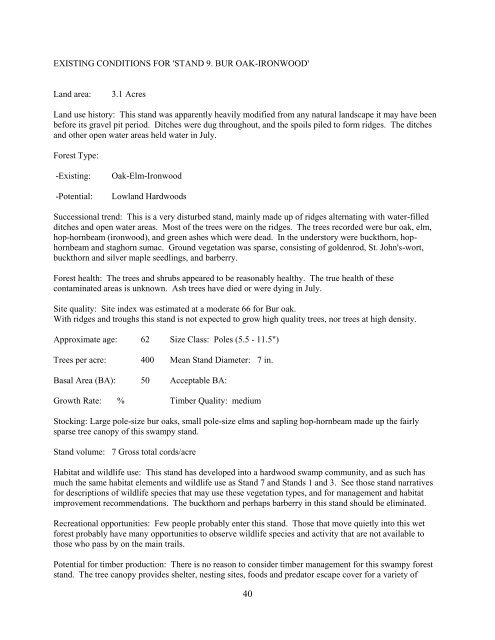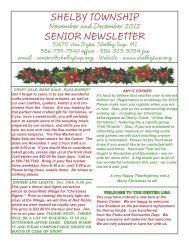RIVER BENDS PARK-WEST AND HOLLAND ... - Shelby Township
RIVER BENDS PARK-WEST AND HOLLAND ... - Shelby Township
RIVER BENDS PARK-WEST AND HOLLAND ... - Shelby Township
You also want an ePaper? Increase the reach of your titles
YUMPU automatically turns print PDFs into web optimized ePapers that Google loves.
EXISTING CONDITIONS FOR 'ST<strong>AND</strong> 9. BUR OAK-IRONWOOD'<br />
Land area: 3.1 Acres<br />
Land use history: This stand was apparently heavily modified from any natural landscape it may have been<br />
before its gravel pit period. Ditches were dug throughout, and the spoils piled to form ridges. The ditches<br />
and other open water areas held water in July.<br />
Forest Type:<br />
-Existing: Oak-Elm-Ironwood<br />
-Potential: Lowland Hardwoods<br />
Successional trend: This is a very disturbed stand, mainly made up of ridges alternating with water-filled<br />
ditches and open water areas. Most of the trees were on the ridges. The trees recorded were bur oak, elm,<br />
hop-hornbeam (ironwood), and green ashes which were dead. In the understory were buckthorn, hophornbeam<br />
and staghorn sumac. Ground vegetation was sparse, consisting of goldenrod, St. John's-wort,<br />
buckthorn and silver maple seedlings, and barberry.<br />
Forest health: The trees and shrubs appeared to be reasonably healthy. The true health of these<br />
contaminated areas is unknown. Ash trees have died or were dying in July.<br />
Site quality: Site index was estimated at a moderate 66 for Bur oak.<br />
With ridges and troughs this stand is not expected to grow high quality trees, nor trees at high density.<br />
Approximate age: 62 Size Class: Poles (5.5 - 11.5")<br />
Trees per acre: 400 Mean Stand Diameter: 7 in.<br />
Basal Area (BA): 50 Acceptable BA:<br />
Growth Rate: % Timber Quality: medium<br />
Stocking: Large pole-size bur oaks, small pole-size elms and sapling hop-hornbeam made up the fairly<br />
sparse tree canopy of this swampy stand.<br />
Stand volume: 7 Gross total cords/acre<br />
Habitat and wildlife use: This stand has developed into a hardwood swamp community, and as such has<br />
much the same habitat elements and wildlife use as Stand 7 and Stands 1 and 3. See those stand narratives<br />
for descriptions of wildlife species that may use these vegetation types, and for management and habitat<br />
improvement recommendations. The buckthorn and perhaps barberry in this stand should be eliminated.<br />
Recreational opportunities: Few people probably enter this stand. Those that move quietly into this wet<br />
forest probably have many opportunities to observe wildlife species and activity that are not available to<br />
those who pass by on the main trails.<br />
Potential for timber production: There is no reason to consider timber management for this swampy forest<br />
stand. The tree canopy provides shelter, nesting sites, foods and predator escape cover for a variety of<br />
40



